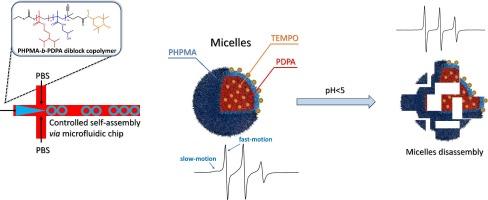利用散射和 EPR 技术探测 pH 值敏感嵌段共聚物纳米粒子的内部结构和动力学特性
IF 5.8
2区 化学
Q1 POLYMER SCIENCE
引用次数: 0
摘要
这项研究强调了电子顺磁共振 (EPR) 光谱在纳米粒子分析中的关键作用,展示了其探测分子级细节的独特能力。我们展示了一类新型 pH 响应型两亲性二嵌段共聚物的合成和自组装,特别是聚[N-(2-羟基丙基)-甲基丙烯酰胺]-嵌段-聚[2-(二异丙基氨基)乙基甲基丙烯酸酯](PHPMA-b-PDPA),其中包含与亲水性 PHPMA 段共价结合的 2,2,6,6-四甲基哌啶-1-氧(TEMPO)自由基。共聚物的合成过程分为三个步骤,将可逆加成-断裂链转移(RAFT)聚合与碳化二亚胺(DCC)化学结合在一起。含 TEMPO 自由基的纳米颗粒(RNPs)是利用微流体(MF)纳米沉淀法制成的,这种技术对于生成具有可预测的生物分布和细胞吸收的均匀纳米颗粒至关重要。调整 MF 方案参数可对 RNP 大小进行微调。EPR 光谱证实了核壳 RNP 的形成,其特征与动态光散射 (DLS)、静态光散射 (SLS)、小角 X 射线散射 (SAXS) 和冷冻透射电子显微镜 (cryo-TEM) 等散射技术所获得的特征非常吻合。EPR 光谱是对胶体聚合物系统进行分子级分析的有效工具。本研究强调了 EPR 自旋标签法在探测核壳纳米粒子内部结构特征和动态方面的功效,尤其是它们对 pH 触发的解体的反应。这些发现为将 pH 响应型 TEMPO 标记的二嵌段共聚物用于可控药物递送应用开辟了新的途径。本文章由计算机程序翻译,如有差异,请以英文原文为准。

Probing the inner structure and dynamics of pH-sensitive block copolymer nanoparticles with nitroxide radicals using scattering and EPR techniques
This research emphasizes the crucial role of electron paramagnetic resonance (EPR) spectroscopy in nanoparticle analysis, showcasing its distinctive ability to probe molecular-level details. We demonstrate the synthesis and self-assembly of a new class of pH-responsive amphiphilic diblock copolymers, specifically poly[N-(2-hydroxypropyl)-methacrylamide]-block-poly[2-(diisopropylamino)ethyl methacrylate] (PHPMA-b-PDPA), incorporating 2,2,6,6-tetramethylpiperidine-1-oxyl (TEMPO) radicals covalently bound to the hydrophilic PHPMA segment. The copolymer synthesis involved a three-step process, combining reversible addition − fragmentation chain transfer (RAFT) polymerization with carbodiimide (DCC) chemistry. TEMPO radical-containing nanoparticles (RNPs) were created using microfluidic (MF) nanoprecipitation, a technique essential for generating uniform nanoparticles with predictable biodistribution and cellular uptake. Adjusting MF protocol parameters allowed fine-tuning of RNP sizes. EPR spectroscopy confirmed the formation of core–shell RNPs, with features aligning closely with those obtained from scattering techniques like dynamic light scattering (DLS), static light scattering (SLS), small-angle X-ray scattering (SAXS), and cryo-transmission electron microscopy (cryo-TEM). EPR spectroscopy emerges as a potent tool for molecular-level analysis of colloidal polymer systems. This study highlights the EPR-spin label method’s efficacy in probing the internal structural features and dynamics of core–shell nanoparticles, especially their response to pH-triggered disassembly. The findings open new avenues for the use of pH-responsive TEMPO-labeled diblock copolymers in controlled drug delivery applications.
求助全文
通过发布文献求助,成功后即可免费获取论文全文。
去求助
来源期刊

European Polymer Journal
化学-高分子科学
CiteScore
9.90
自引率
10.00%
发文量
691
审稿时长
23 days
期刊介绍:
European Polymer Journal is dedicated to publishing work on fundamental and applied polymer chemistry and macromolecular materials. The journal covers all aspects of polymer synthesis, including polymerization mechanisms and chemical functional transformations, with a focus on novel polymers and the relationships between molecular structure and polymer properties. In addition, we welcome submissions on bio-based or renewable polymers, stimuli-responsive systems and polymer bio-hybrids. European Polymer Journal also publishes research on the biomedical application of polymers, including drug delivery and regenerative medicine. The main scope is covered but not limited to the following core research areas:
Polymer synthesis and functionalization
• Novel synthetic routes for polymerization, functional modification, controlled/living polymerization and precision polymers.
Stimuli-responsive polymers
• Including shape memory and self-healing polymers.
Supramolecular polymers and self-assembly
• Molecular recognition and higher order polymer structures.
Renewable and sustainable polymers
• Bio-based, biodegradable and anti-microbial polymers and polymeric bio-nanocomposites.
Polymers at interfaces and surfaces
• Chemistry and engineering of surfaces with biological relevance, including patterning, antifouling polymers and polymers for membrane applications.
Biomedical applications and nanomedicine
• Polymers for regenerative medicine, drug delivery molecular release and gene therapy
The scope of European Polymer Journal no longer includes Polymer Physics.
 求助内容:
求助内容: 应助结果提醒方式:
应助结果提醒方式:


